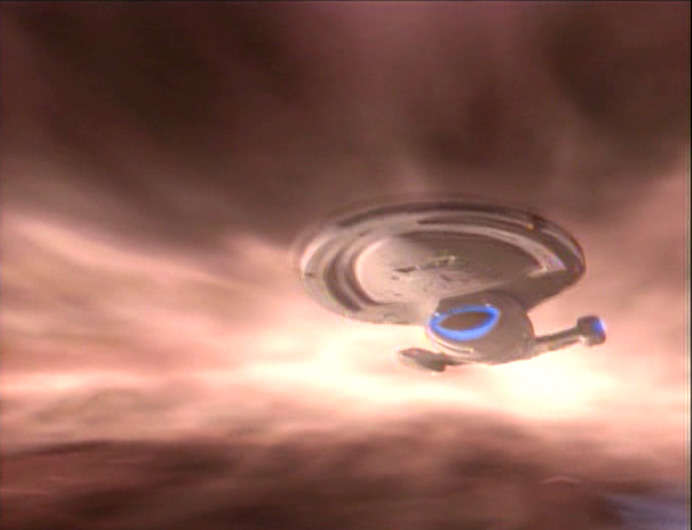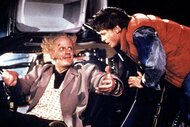Create a free profile to get unlimited access to exclusive videos, sweepstakes, and more!
Can we build Star Trek: Voyager's Displacement Wave? The Science Behind the Fiction

Star Trek: Voyager, the first series to spend the majority of its time outside the Alpha Quadrant, ran for 172 episodes, airing its final episode 20 years ago this week. It began in a familiar way, a Starfleet mission to locate a missing ship. But the crew of Voyager quickly encounters an unusual phenomenon.
A displacement wave, traveling at incredible speed, makes contact with the ship, killing several members of the crew. When the dust settles, Voyager finds itself in the Delta Quadrant, having traveled more than 70,000 light-years from Earth. Even by Trek standards, the Voyager was going really, really fast. But is there any real-life counterpart to this futuristic faster-than-light travel?
DISPLACEMENT
Star Trek couldn't exist as a franchise without displacement. The warp drives utilized on Federation ships depend on displacement of space-time in order to circumvent relativity and the light-speed barrier. The displacement wave seen in the first episode of Voyager takes this process to an extreme via the Caretaker, an entity tasked with the protection of the Ocampa people. The Caretaker, noting his own imminent demise, uses displacement arrays to gather various species from around the galaxy in the hope of finding a compatible species to take over his task.
The exact nature of the wave is never clearly explained, what is clear is the wave's ability to rapidly transport craft and crew across vast distances without violating relativity.
The Milky Way has a diameter of 100,000 light-years and the crews of Voyager and the Maquis ship cover most of that distance in moments. Making that distance through ordinary acceleration would require speeds tens of thousands of times that of light-speed (C), or a really, really long time. Traveling at that speed would result in incredible time dilation, such that when the crew did eventually return home, they would return to a world entirely unrecognizable — if there was a world to return to at all. The only workable explanation is the creation of a space-time bubble that moved the ships without violating C inside localized space-time.
RELATIVISTIC LIMITS OF SPEED
The first thing to understand is that the speed of light actually has nothing to do with light, it's just the most apparent way of measuring the cosmic speed limit. The speed of light (186,282 miles per second) is more accurately thought of as the speed of causality.
Gravity waves, photons, and gluons all travel at C. The common characteristic they all share is they are massless. The cosmic speed limit is the maximum speed at which any two particles can communicate or interact with one another.
There's a common thought experiment involving a very long stick which helps to illustrate this point. It goes as follows. Imagine a button one light-minute away, capable of being triggered in two ways. The first is by interaction with light, the second is by being pressed with a stick. Now imagine you have a stick one light-minute across resting against the button. You shine a light at the button and push the stick at the same time. What happens?
The intuitive answer is the stick would press the button instantly, while the light would take a full minute to reach its destination. But that isn't what would happen. When you move a stick in your backyard, it appears to move together all at once, but force is being communicated and it's happening at the cosmic speed limit or slower. It seems instant because the distances involved are very small, cosmically speaking.
A stick one light-minute across would need to transmit the force of motion along its length before interacting with the button. The fastest this could happen is C. In actuality, it would happen more slowly because the force is moving through a medium — the stick — not through a vacuum.
Whether or not any light is present is irrelevant. The cosmic speed limit is the speed of causality and matter slows things down.
The key takeaway is that the maximum speed limit within any localized area of space is C. There's no going any faster. But that doesn't necessarily hold true between two non-local areas of space.
We all know the universe is expanding and more distant objects are receding from us at faster rates. If you look far enough into the distance, you'll find galaxies traveling away from us faster than the cosmic speed limit. This is because of the nature of expansion. Every part of the universe is expanding at the same rate, as a result, the farther you look, the more that expansion adds up. It seems counterintuitive but it's true. And, it tells us something really important about rates of travel.
The cosmic speed limit cannot be exceeded within a local area of space-time, but you can manipulate space-time in such a way that space-time itself exceeds the limit. Therein lies the key to potential faster-than-light travel.
BREAKING THE LIMIT
Exceeding the light-speed barrier has been a long-time staple of science fiction, but Star Trek holds the honor of its most well-known incarnation with the iconic Warp Drive. It makes for good fiction but seems to fly in the face of general relativity.
Enter Miguel Alcubierre, a physicist and Star Trek fan. In fact, Alcubierre was inspired by Star Trek when thinking about his hypothetical model. What's become known as the Alcubierre drive describes a way to encapsulate a craft inside a localized bubble of space-time while manipulating the space around it.
The space in front of the craft would be compressed while the space behind it expands. The craft inside the bubble never exceeds the light-speed barrier through its own local space-time. Instead, it travels by riding a sort of space-time wave. It would be like shrinking a ten-mile commute down to a quarter-mile and just putting the rest of the commute behind you. Suddenly, you can make the trip in just a couple of minutes without ever breaking the speed limit.
The idea was exciting in that it allows for possible FTL travel without violating relativity. There were just a few hang-ups, it requires either negative mass or a ring of negative energy to operate. And, the amount of matter needed to create the energy required exceeds the mass of the observable universe. That's a pretty big problem to have.
Subsequent work by other scientists has refined Alcubierre's idea such that the mass needed is closer to that of the Sun. To be sure, that's a huge improvement over the whole of the universe, but it's still a lot. Considering our current technological capabilities, they might as well be the same thing.
Even if we could get the mass required down to a manageable amount, there's yet another hurdle. Once inside this warped bubble of space-time, there would be no way to escape from the inside. The ship would effectively be in a locked room with no doors or windows.
A warp drive, or displacement wave, remains well within the confines of science fiction for now. But we've crossed seemingly uncrossable horizons before, and we've got a couple of centuries before the Vulcans come looking for us. There's still time.














